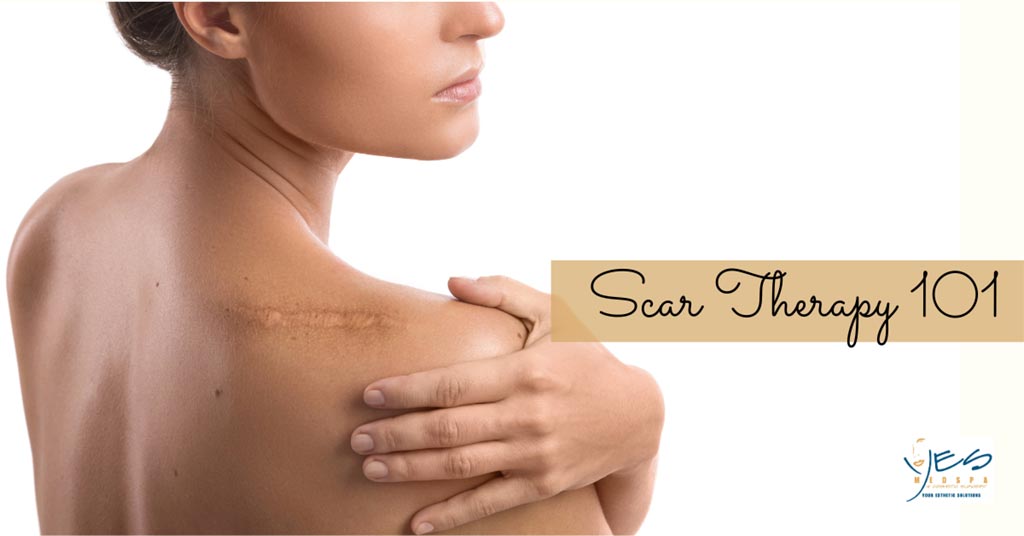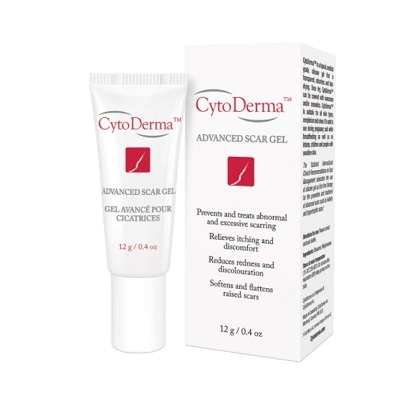At YES Medspa & Cosmetic Surgery Centre, our goal is to help you achieve Your Esthetic Solutions. Many men and women come to our plastic surgery practice in Vancouver, bothered by the appearance of their scars. Whether the scars are a result of acne, trauma, or surgery, they can leave a lasting mark on your skin as well as your self-esteem. In this blog post, we will explore how to fade plastic surgery and acne scars with our scar therapy treatments and what to expect from each.
What causes scar tissue?
Before we discuss scar treatments, let’s first understand why scars develop. Scars form whenever the skin is injured. After surgery, scar tissue forms along the incision line. The body creates new collagen as part of the healing process. This collagen-infused tissue is randomly placed to help close the wound but eventually becomes more organized and aligned to provide strength to the injured area.
With minor injuries, this repair process results in a scar that is usually unremarkable. With deeper wounds or those associated with trauma or surgery, the collagen fibres may remain randomly aligned or in random patterns, resulting in scar tissue that is firmer, more colourful, or textured. For many patients, pigment-producing cells called melanocytes overproduce pigment when injured, causing the scars to turn darker. These problems are magnified in patients with darker skin types or who have had extensive UV light exposure to the immature scar.
How do surgical scars heal?
How a scar heals and forms depends on several factors. Skilled plastic surgery techniques can be very helpful, but many other factors contribute to less-than-ideal-appearing scars. Some patients have healing patterns that make them prone to raised, colourful, and wider scars, while others are prone to weaker scars.
Even when a normal scar occurs, whether on a more publicly visible location or a private part of the body, patients often seek options to improve the appearance of these scars. For this reason, we offer advice and a number of different treatments, strategies, and products to our clients.
What is the best way to treat a scar?
As one of the premier plastic surgery centres in the region, we see scars of all ages and stages of healing. Medical Director Dr. Matthew Mosher, a Royal College-certified cosmetic plastic surgeon with over 2 decades of experience, has developed a number of scar management protocols for his surgery patients. These strategies are routinely included in their post-surgical care.
Sometimes, scars are best managed with surgery or medical treatments. Our experienced physician oversight ensures that the best option is selected for each patient.
For YES Cosmetic Surgical patients, we educate and treat them with optimized post-operative wound care to give healing the best opportunity to achieve a normal and, hopefully, discreet-appearing scar. Scientific evidence-based techniques and topical products, such as CytoDerma, are utilized for every procedure.
These healing techniques include strategies to:
- Avoid infection
- Minimize inflammation
- Encourage rapid healing.
Pressure therapy, mechanical wound support, and hydration of the incision are also utilized. Once the wounds have closed and any sutures or staples have been removed, many of these principles continue for 4 to 6 weeks.
What laser or energy-based treatment is best for scars?
Energy-based scar treatments can be selectively considered for early or old scars that will not benefit from further surgical or medical treatment.
Laser Hair Reduction
Hair follicles that become trapped within a scar can interfere with achieving the best possible final scar appearance. Unwanted hair growth and some common hair grooming practices may also worsen acne and perpetuate inflammation within a scar.
Laser hair reduction is a safe method of permanently reducing the growth of darker and coarser hairs. For patients with pigmented scars from ingrown hairs or acne caused by hair follicles, reducing hair growth will positively impact the acne and associated scars. A series of 6 or more treatments spaced several weeks apart may be recommended for selected scar management.
Laser Non-Ablative Resurfacing
Fractional laser treatments are gentle yet powerful. This advanced technology, offered under the diligent supervision of Dr. Mosher, helps lighten and smooth scars and stretch marks by reducing red/purple tones to the scar and boosting collagen production within the skin.
This technology treats tiny pinpoint vertical columns of tissue (fractions) within the scar without creating a new injury to the scar surface. This means that there is no extension of social “downtime” (recovery time when you may feel self-conscious about being seen) and no new wound care required.
Mild swelling and redness can persist for up to 3 days, and it is recommended that you avoid sun exposure and overly warm activities, such as hot tubs and saunas, for 48 hours. We recommend a series of 3 to 6 treatments (each a few weeks apart) to improve the texture and colour of scars, both young and old. This technology is most helpful for superficial scars and stretch marks on skin of all colours.
Intense Pulsed Light Therapy (IPL)
Light-based treatments, such as IPL, target hyperpigmentation (brown discolouration) and excess vascularity (red discolouration) within and adjacent to a scar. This technology selectively damages, disperses, or injures the source of unwanted scar colour.
Intense pulsed light devices have been around for more than 20 years. Just like all other technology, this modality has become safer, more effective, and more efficient over time. After treatment, the body “cleans up” the excess colour, and the overall scar fades. Another side benefit of this treatment is the gentle stimulation of new collagen.
For patients with lighter skin tones and discoloured scars, 3 to 5 treatments are recommended, spaced 3 to 4 weeks apart. There is little to no downtime with IPL treatments. Mild swelling and redness can persist for 1 to 5 days. We recommend avoiding sun exposure and excessive heat after this treatment as well.
RF Microneedling
Radiofrequency-enhanced microneedling treatments can be used to stimulate collagen production and scar tissue reorganization to soften and flatten the appearance of deeper and more textured surgical or injury-related scars. Much like lasers and IPL, this technology has rapidly evolved.
Our Morpheus8 platform has been a “game-changer.” Tiny and precise puncture wounds carefully customized to the scar characteristics penetrate to a specific depth. Once fully deployed, the needles deliver controlled heat via radiofrequency (RF) energy into the scar and adjacent skin. These small, controlled injuries powerfully stimulate repair and increase the production of collagen and elastin. The customization of the treatment parameters and skilled delivery of these treatments is an important part of what we do at YES Medspa.
We also use Morpheus8 to improve thin, “wavy,” and discoloured skin associated with stretch marks. More versatile and safe than many laser and light-based systems, this can be used anywhere on the body and on any skin type. We recommend a series of 3 to 4 treatments, spaced 1 month apart. Clients can expect 1 to 2 days of light redness and minimal swelling. Learn more about what to expect with Morpheus8 in our related blog post.
Find Your Perfect Treatment
If you’re wondering which scar therapy treatment is right for you, our medical spa team or plastic surgeons near Vancouver can help. Contact us at (604) 888-9378 to schedule an appointment or request a consultation online.
Say Y.E.S. to smooth, healthy-looking skin.
Updated February 2025










Hi I am curious as to the cost of the micro needling. I have had two fractional laser treatments done to my face about 15 years ago. I had a micro needling done last year at a spa, but I don’t think the depth of needle was enough. I have ice pick type scars on both cheeks from acne as a teen. They can be covered with makeup, but they bother me and I’d like their appearance reduced, if possible. I am 50 years old. Thank you
Hi Dawn, Thank you for your comment/inquiry. Pricing is determined by the size of the area being treated and the number of treatments recommended. The average acne scar patient will require 3-4 treatments spaced 4-6 weeks apart. We will send you an email to discuss your particular situation in more detail. Consultations with our medical aestheticians are complimentary. They will be able to create a custom treatment plan for you.